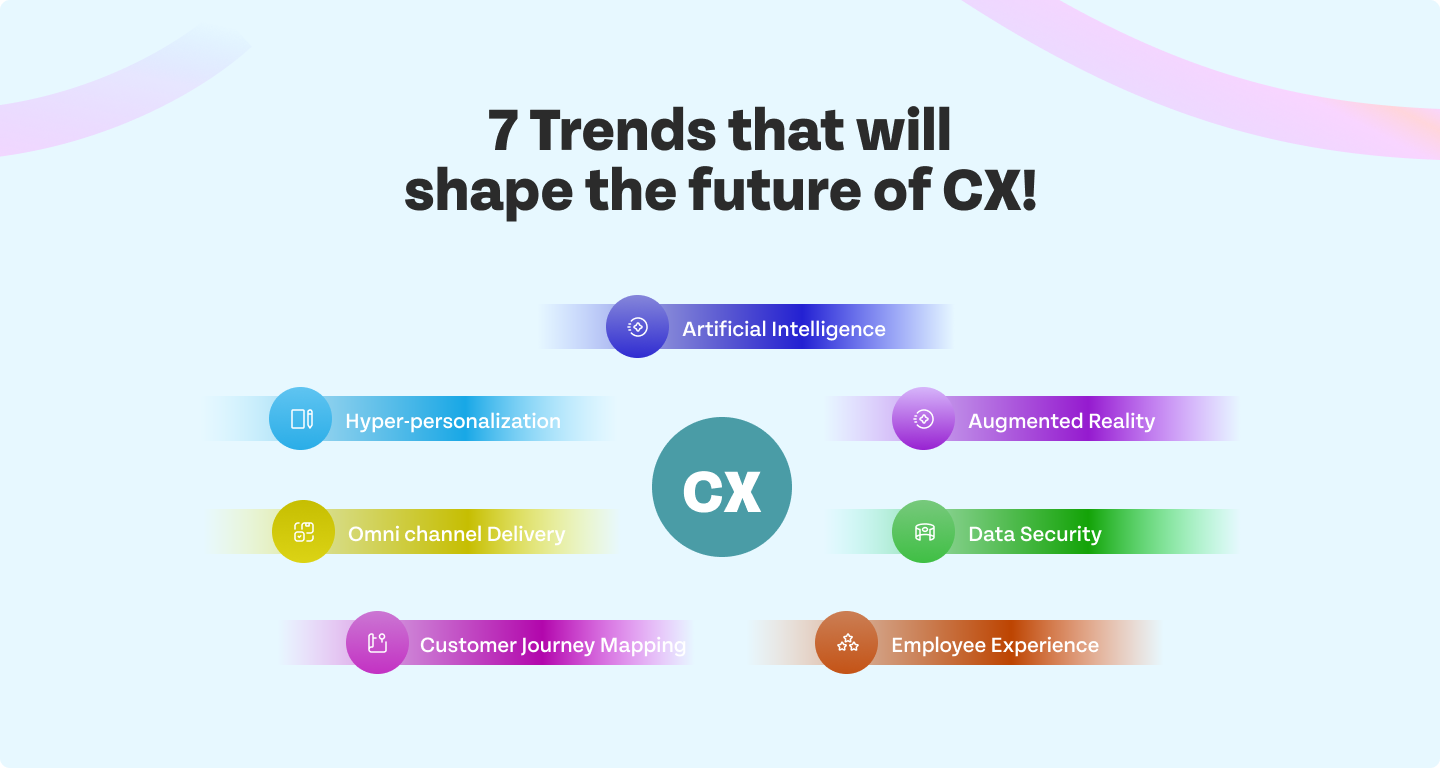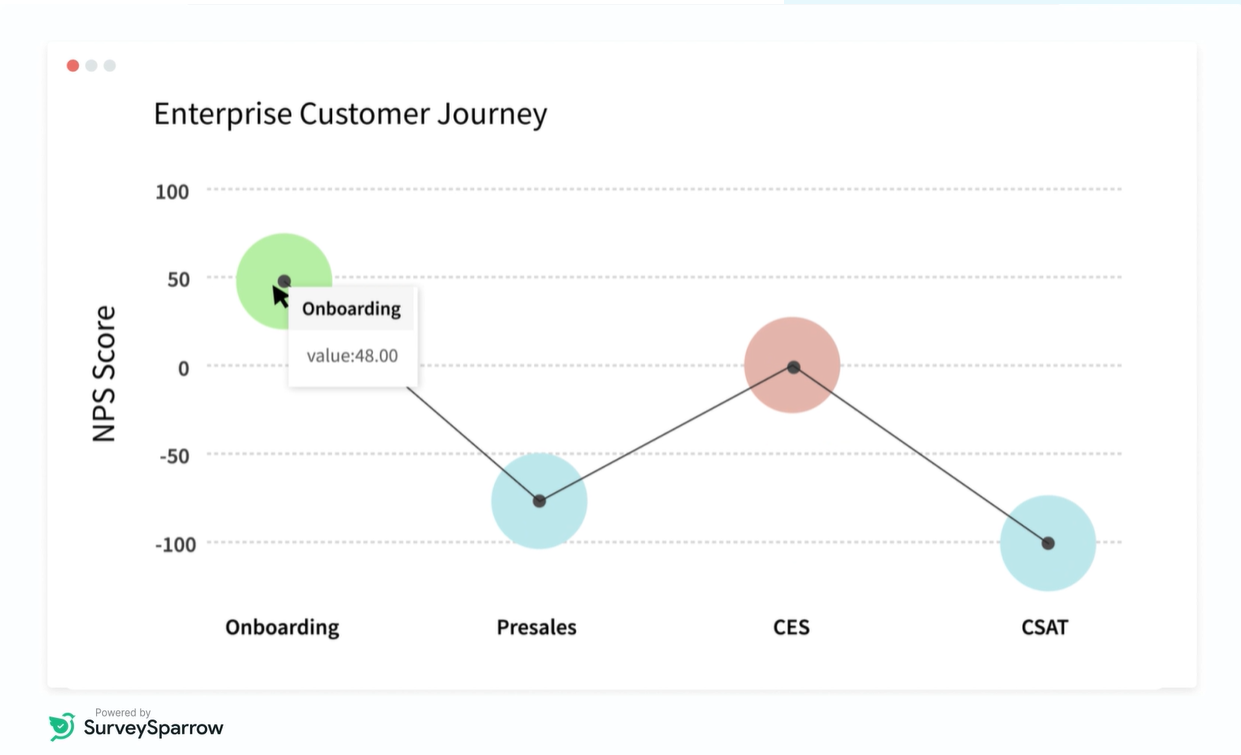Best Of
The Future Of Customer Experience: 7 Trends That Will Define It
Article written by Kate Williams
Product Marketing Manager at SurveySparrow
12 min read
23 April 2025

Companies with a customer experience mindset today earn 4- 8% more revenue than their competitors. As a result, customer experience has become a competitive advantage, key differentiator, loyalty booster, and a driver for repeat purchases. So then, with the sweeping digitization of businesses, what will the future of customer experience look like?

Let us delve into how these trends will shape the future of CX.
- Artificial Intelligence
- Augmented Reality
- Data Security
- Employee Experience
- Customer Journey Mapping
- Omnichannel Delivery
- Hyper-personalization
1. Artificial Intelligence
For a long time, artificial intelligence was the buzzword for enterprises and Silicon Valley startups. However, small businesses and SMBs are finding more incentives to use AI to reap big benefits in areas like customer experience management, employee performance, and much more.
Some uses of AI in the future of customer experience include:
A. Chatbots
From Eliza to Alexa, chatbots have been around since the 1960s. But as the pandemic swept the world, many businesses came to rely on chatbots to automate customer communications – from 24/7 customer support to customer engagement, from product recommendations to updates, and more. And these bots will only keep growing and evolving from here.
- In the future, chatbots will no longer be used as standalone tools but as engagement tools connected to other platforms. Think of a chatbot mascot – one that can interact with your customers across all your channels like website, messaging, and social.
- What’s more, messaging apps like WhatsApp are opening their doors to conversational commerce. Soon, automated WhatsApp messaging bots will enable your customers to explore your products, shop, and track their purchases via chat.
- No-code chatbots are also going to be big in 2022. With code-free features, design elements, and real-time data analysis, no-code bots reduce the time, training, and complexity involved in the development and IT. As a result, more small businesses and startups can access chatbot tech.
B. AI Surveys
When we talk about the role of artificial intelligence in customer experience, AI Surveys take a giant leap ahead. AI Surveys are advanced tools designed for efficient and intelligent survey creation and analysis. They feature AI-powered question generation for personalized surveys, real-time data analysis, and sentiment analysis to understand respondents’ emotions. This technology streamlines data collection and enhances the interpretation of survey results, providing deeper insights and improving decision-making processes.
Some of the benefits of AI surveys include:
- Intelligent Creation: AI for easy, personalized survey design.
- Real-Time Analysis: Instant insights from survey responses.
- Sentiment Analysis: Understands emotions in feedback.
- Efficient Data Collection: Streamlined by AI.
- Enhanced Insights: AI simplifies result interpretation.
- Ready Templates: For specific feedback topics.
- AI-Driven Insights: Deeper analysis for impactful surveys.
You can create AI surveys, using tools like SurveySparrow. With features like AI Wing, and CogniVue, you can create surveys using prompts, rephrase the questions to match your tone, and do in-depth sentiment analysis.
Here’s a sample survey created with SurveySparrow
Customer Experience Survey
Use This TemplateC. Customer Relationship Management
AI will be integrated into CRM platforms to improve predictive analytics and real-time decision-making. By studying previous scenarios where the deals were closed, ghosted, or outright rejected, the AI can capture insights into the customer’s decisions. Then, the AI platform will use these insights to recommend the next best course of action.
- Combined with chatbots, AI tools will also be virtual sales agents.
- They will act as the first point of contact between the lead and the human agent.
- Once the lead is qualified, the human agent will take charge and close it. This will enable your team to cast a wider net and follow up on every lead.
D. Virtual Assistants & Voice Assistants
According to Capgemini Research Institute reports, about 70% of people will gradually swap in-store visits for voice assistants by 2022. It’s easy to understand why.
- Interacting with a voice assistant feels like talking with a friend – one that supports you 24/7.
- This creates a more personalized experience for shoppers.
2. Augmented Reality
Products and services are the two touchpoints that customers engage with daily. As a result, there is a growing need for an interactive experience while using them. This has accelerated AR solutions for the future of customer experience.
- The primary use case of augmented reality lies in product visualization – a combo of a real-world and virtual environment.
- By overlapping digital content with the real world, it enables users to experience how a product will appear in the physical world in real time. Balenciaga and Fortnite’s ground-breaking collaboration takes this to a whole new level, combining the physical and digital worlds for a fully immersive experience.
- AR will also be leveraged for technical support by creating AR user manuals, AR remote assistance, and AR customer service. For example, with the aid of AR, support agents can assess customer issues in real-time and clarify the issue with image markups.
- This visual guidance with AR will be as if the support agent standing side-by-side with the customer. By overlaying instructions on physical reality rather than the screen, AR will be a game-changer in customer support.
3. Data Security
According to a survey by Entrust, 64% of consumers are willing to trade their personal data for personalized services. But a growing number – 79% – are concerned about their data privacy. It pretty much goes without saying that customer data (collected with their consent, of course!) should be protected from security breaches. So, what are other cybersecurity trends that will shape the future of customer experience?
- A report by Infosec states that about 97% of the people in the world can’t identify a phishing email! Aside from this, criminals are using more sophisticated cyber-attacks.
- So to prevent corporate data from falling into the wrong hands, businesses must regularly implement cyber-awareness training for their employees.
- Regional data protection regulations will have a global impact, forcing businesses to prioritize data security and transparency. For example, the General Data Protection Regulation Act (GDPR) is enforced in the EU region.
- It accords citizens with the right to be forgotten – to have their personal data records deleted on request. Any company that markets goods or services to EU residents must comply with the GDPR regardless of their location.
Given the rising awareness and regulatory requirements pertaining to data security, staying on top of cybersecurity trends plays right into the gambit of enhanced customer experiences. There are a wide range of guides, systems, and frameworks pertaining to the same, and here are some of the best tools to prevent cyber threats for businesses of all sizes.
4. Employee Experience
It goes without saying: happy employees are the key to happy customers. So here are the employee experience trends that will shape customer experience in the future.
- Monitoring performance and getting feedback is hard enough in a physical office. It becomes even more challenging in the new remote/hybrid workspace.
- Performance management tools and peer-to-peer reward systems will be essential to help lessen the disconnect.
- It will no longer be enough for HR to support only company goals. According to the Bureau of Labor Statistics, 15.6 million new jobs will be added to the US economy in 2022.
- So, to retain their talent, HR and managers will have to understand what motivates them and what they need to be their best.
- Businesses will follow a more individual, data-led approach to create meaningful experiences for each employee. With comprehensive performance analysis and frequent feedback loops, companies will better understand employee expectations and align them to business goals.
- In addition, efforts must be made to incorporate employee wellness sessions, training, and guidance to improve the employee experience.
5. Customer Journey Mapping
Customer journey mapping refers to the process of creating a customer map. A customer map is used to visualize the multiple touchpoints a person interacted with on their journey to becoming your customer – social media, your website, offline, etc. So, what are the uses of customer maps?
- Customer experience varies at each stage of the journey. The customer map is how you can identify their needs and pain points at each stage.
- Customer journey maps assess your customer’s actual needs. This way, you can plan how best to serve their needs.
- You can compare the actual customer experience with what they expected – or the benchmarked standard if there is one.
- Analyze the buying funnel as they move through the various stages of the funnel: Basic Awareness, Keen Interest, Desire, Decision, and finally, Action.
- The end game is to get information that lets you know them better than your competitors and personalize your services accordingly.

6. Omnichannel Delivery
Omnichannel customer experience allows you to get a bird’s eye view of your customer journey at each touchpoint. Now, omnichannel experiences are not new. Even before the global pandemic, consumers were shifting to a mix of online and offline interactions.
But when shops limited in-person visits, online orders and no-contact deliveries became a lifeline for consumers. Omnichannel CX had a vital role to play in this. So, what are the omnichannel trends that will shape the future of customer experience?
- Through real-time results, omnichannel technology will deliver optimized data for your staff. This will enable staff to personalize the experience for customers across multiple channels.
- Through a blend of AR and VR, businesses will overcome physical limitations to drive personalized shopping experiences. For example, customers will use AR apps to try on jewelry virtually. As another example, smartphone scanners or cameras will allow prospective homeowners to see what their home project will look like when finished.
- Sustainability is not an option anymore. Your consumers prefer brands with a strong environmental commitment, and audiences are quick to spot fakery.
- In other words, there is a vast, untapped potential for sustainable practices that are also verifiable. So companies that use omnichannel technology to promote transparent sustainability will win in the long term.
7. Hyper-personalization
One of the keys to a successful customer experience is knowing what to automate – and what not to. Customers today prefer a mix of digital and human interactions. By using customer data platforms like SurveySparrow, stores can seamlessly enhance and personalize the human experience provided by staff.
Giants like Amazon, Netflix, and Facebook have mastered the art of personalization via customer data. Now it’s the turn of smaller businesses to get in on the game. So what are the other personalization trends that will shape the future of CX?
- With all the fuss around millennials, brands seem to have forgotten an under-served segment – shoppers 50 years and older. Senior shoppers are becoming savvier, according to Forbes, as the pandemic forced them to adapt to online shopping and telehealth consultations.
- Consequently, demand for smart home devices and assistive tech will go up. As a result, companies that make their marketing and services senior-friendly will gain the winning edge.
- As more people use ad blockers and tighten their privacy settings, businesses that want to hyper-personalize will have to walk a fine line between charming and creepy.
- Rest assured, your customers want you to provide personalized experiences – but without invading their personal space. While these objectives may seem like oil and water, there are ways to do so.
Wrapping Up
In this article, we’ve briefly discussed the trends that will shape the evolution of customer experience in these 7 areas: artificial intelligence, augmented reality, data security, employee experience, customer journeys, omnichannel delivery, and hyper-personalization.
However, there is no one-size-fits-all approach. Regardless of sector, a business can provide a stellar customer experience simply by running their business ethically and in a way that helps their customers. Feedback is crucial for this – if not through customer satisfaction surveys, then by quickly catching and following up on negative feedback. Platforms like SurveySparrow combine employee feedback, customer journey data, and omnichannel delivery to help you stay ahead of the curve.
You can create a free account to explore all of our features.
A personalized walkthrough by our experts. No strings attached!
Start 14 Days free trial

Kate Williams
Excels in empowering visionary companies through storytelling and strategic go-to-market planning. With extensive experience in product marketing and customer experience management, she is an accomplished author, podcast host, and mentor, sharing her expertise across diverse platforms and audiences.
Related Articles

Compare
Qualtrics vs Google Forms: Which Is Right for You?
10 MINUTES
30 May 2023

Startup Journey
5 Ways SurveySparrow’s Partnership with Rybbon Helps Boost Your Survey Response Rates
3 MINUTES
21 August 2019

Customer Experience
How to Create a Retail Customer Journey Map
9 MINUTES
15 December 2022

Knowledge
Gamified Surveys: Everything You Need To Know
16 MINUTES
7 July 2021
